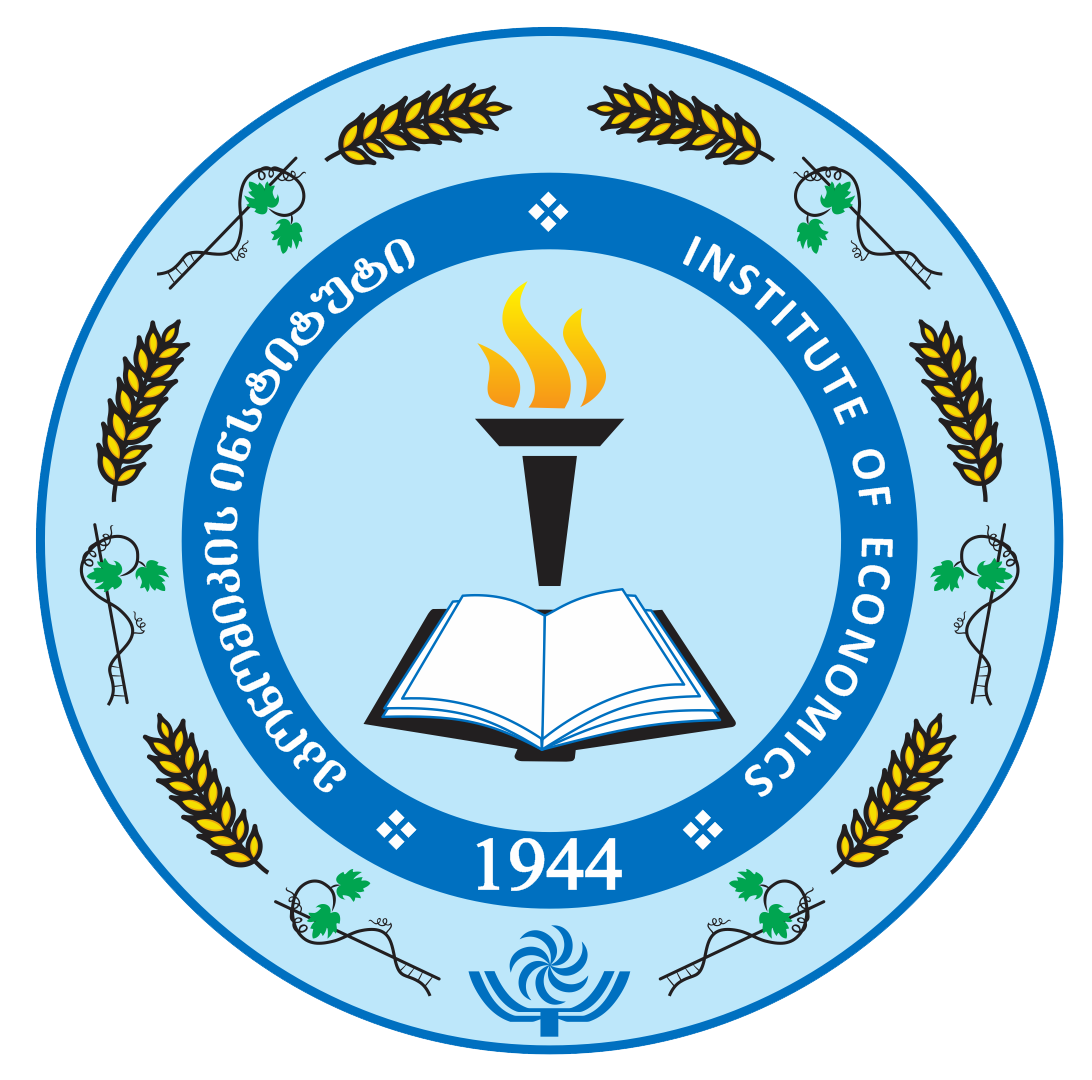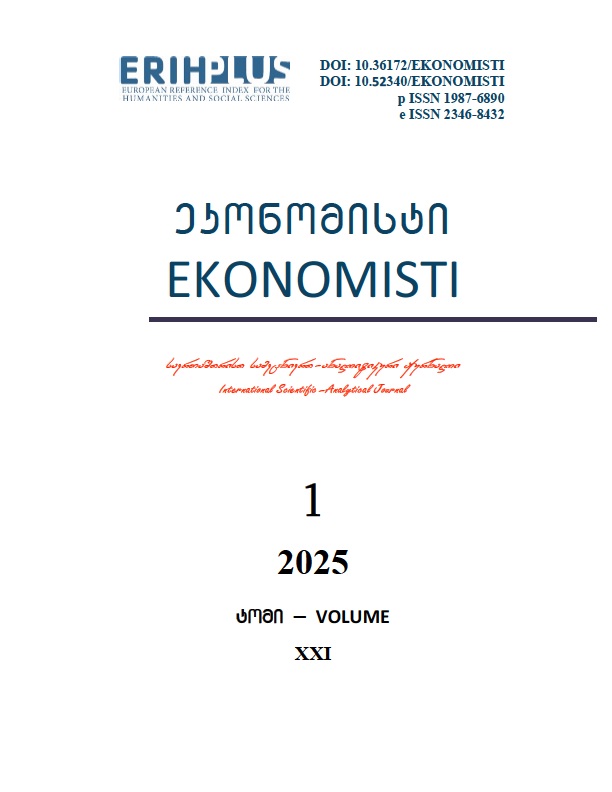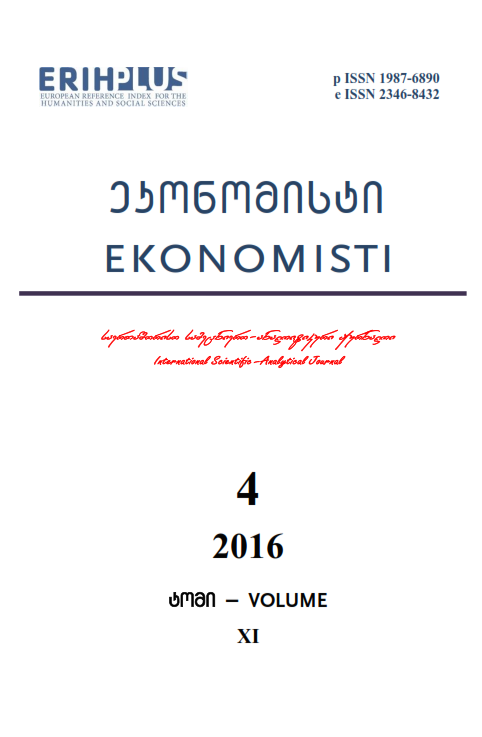
The international scientific and analytical, reviewed, printing and electronic journal of Paata Gugushvili Institute of Economics of Ivane Javakhishvili Tbilisi State University

Possibilities of econometric and statistical modeling of incomes and expenditures of Georgian households by small areas
Expanded Summary
Doi: 10.36172/EKONOMISTI.2022.XVIII.03.Giorgi.Miqeladze
The objective of the paper is to establish the feasibility of estimating households incomes and expenditures on the example of Georgia in a small territorial area, particularly at the municipal level.
The source of households incomes, expenditures and other living conditions in Georgia is the Households Incomes and Expenditures Survey (Integrated Household Survey until 2017). The survey is selective, the data is collected monthly, aggregated data are disseminated annually and the indicators are representative of private households in Georgia at the country and administrative region level, and it is are characterized by substantial relative marginal error ranging from 4% to 65% at the municipal level [15, National Statistics Office of Georgia, Electronic Database of Households Incomes and Expenditures Survey, Calculations of the researcher].
The appendix represents the confidence intervals of the households incomes and expenditures calculated per household and the relative marginal errors of the indicators by municipalities. [15, National Statistics Office of Georgia, Electronic Database of Households Incomes and Expenditures Survey, Calculations of the researcher].
Note: Municipalities / districts of Tbilisi are not identified according to the policy of data confidentiality and therefore are randomly numbered. Moreover, the figures are calculated by the researcher using the Households Incomes and Expenditures survey databases, and any inaccuracies in the calculation are his responsibility.
When applying econometric-statistical methods to calculate the incomes and expenditures of private households in Georgia at the municipal level, using the "Household Income and Expenditure Survey" database, the following key fact should be taken into account at the research stage: The sample survey does not include observations from all municipalities of Georgia. Specifically, there are 80 municipalities in Georgia, and the sample of Households Incomes and Expenditures Survey for 2021 includes observations of private households in 79 municipalities.
Feasibility of estimating the incomes and expenditures of Georgian households by small units (municipalities)
For econometric modeling of the 2014 General Census of Georgia and the Households Incomes and Expenditures Survey Databases to estimate the incomes and expenditures of households in Georgia by small territorial units, the following methods can be used:
v The Elbers, Lanjouw, Lanjouw (ELL) model existing at the unit level of the statistical observation.
v Faye-Heriot (FH) model existing at the aggregate unit of the statistical observation (mainly by type of settlement);
v Application of time series regression analysis models on small territorial units.
Elbers, Lanjouw and Lanjouw (ELL) Model existing at the unit level of the statistical observation: To gain a better understanding of the main concept of the model, assume that W is an indicator of poverty or inequality calculated from a database at the household level, namely from the variable. Using relatively small and large datasets, the joint distribution of the and covariation vector, , is estimated. By limiting the number of factor variables, which are also found in both households and general census databases, a linked model can be created to generate for any subpopulation and calculate the corresponding statistic. This, in turn, allows us to generate a conditional distribution of W, which implies its point-by-point estimation and possibility of error determination [8, Elbers, Chris, Jean O. Lanjouw, and Peter Lanjouw].
The method usually consists of two steps. The first stage involves the empirical implementation of the following models based on selective research: 1) beta model - (X) use the OLS method to select factors; 2) Alpha Model - Evaluation of variance of heterosexuality and cluster residual members 3) GLS Model - Evaluation of coefficient values and variation of residual members. In the second stage, the empirical model is realized using a descriptive database. The Monte Carlo simulation can be used in the last stage [8, Elbers, Chris, Jean O. Lanjouw, and Peter Lanjouw].
Faye-Heriot (FH) model existing at the aggregate unit of the statistical observation unit (mainly by type of settlement): The core concept of the model is the following:
Assume we have a small territorial unit of quantity m, i=1,…,m. Assuming that the observable explanatory information of the p x 1 dimension is known in advance for each I territorial unit Xi = (Xi1 . . .Xip)T, the Faye-Heriot model allows to improve the direct ![]() estimation obtained from the observations, based on the true
estimation obtained from the observations, based on the true ![]() of each territorial unit, which is implemented by two stages:
of each territorial unit, which is implemented by two stages:
I stage (Selective model): ![]()
II stage (Connecting model): ![]()
Where „IND“ refers to independence, ![]() represents variation of the selective error,
represents variation of the selective error, ![]() - is a vector matrix of regression coefficients that should be estimated, and
- is a vector matrix of regression coefficients that should be estimated, and ![]() - is an unknown variation of random effects of territorial units. The first stage of the model involves determining the variability of the selective direct estimation
- is an unknown variation of random effects of territorial units. The first stage of the model involves determining the variability of the selective direct estimation ![]() from the actual
from the actual ![]() estimate. While the second stage relates
estimate. While the second stage relates ![]() to the existing observable explanatory variables at the known p small territorial level. The model can be recorded as [9, Fay, Robert E., and Roger A. Herriot.]:
to the existing observable explanatory variables at the known p small territorial level. The model can be recorded as [9, Fay, Robert E., and Roger A. Herriot.]:
![]()
Where ![]() represents the random effect at the level of an independent and identically distributed territorial unit on the unknown
represents the random effect at the level of an independent and identically distributed territorial unit on the unknown ![]() , that should be estimated from the available data,
, that should be estimated from the available data, ![]() is a selective error where the
is a selective error where the ![]() variation is known. If the
variation is known. If the ![]() variation is unknown, then it can be estimated with the basic employment variation function. Moreover, assumptions are made about independence of
variation is unknown, then it can be estimated with the basic employment variation function. Moreover, assumptions are made about independence of ![]() and
and ![]() [9, Fay, Robert E., and Roger A. Herriot].
[9, Fay, Robert E., and Roger A. Herriot].
Application of time series regression analysis models on small territorial units: The use of time series implies the empirical realization of an individual regression model from a small database at the municipal level and the application of this model to large databases. The advantage of using time series is the individual approach to small territorial units, while the disadvantage is the assumption about the interdependence of small units. The undeniable advantage of using time series is the simple opportunities of solving some possible problems. Particularly, due to the small sample size of statistical surveys, it is possible that a certain number of municipalities may not have observations. Mentioned problem can be solved by using several methods: 1) to develop a similarity criterion, that allows to unite municipalities and accordingly the regression equation will be constructed based on the united municipalities; 2) Build a regression model by the region and connect it to the non-selective database according to the mentioned model 3) Build a regression model at the country level and connect it to the non-selective database according to the mentioned model. Note: The last two methods are analogous to the statistical imputation method.
Keywords: Small area estimation, Incomes and Expenditures of Georgian Households, Relative Marginal Errors.

